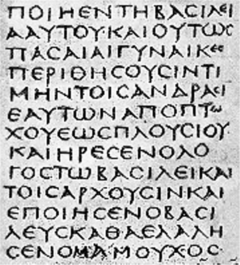Kruger on P. Antinoopolis 12 (0232)
by larryhurtado
Over the weekend I read with interest the newly-published study of the fragment of 2 John known as P.Antinoopolis 12 (Gregory-Aland 0232) by Michael J. Kruger (former PhD student). The manuscript was dated by C.H. Roberts to the 3rd century CE, and proposed that it originally other Johannine writings, making it the earliest evidence of an early “Johannine corpus” of writings. (The single leaf extant has page numbers preserved: 164-165, so the manuscript originally included much more than 2 John.)
Although Roberts’ dating was accepted by some others (notably reflected in J. van Haelst’s widely-used catalogue), Kruger notes that some others (Kurt Aland, G. Cavallo and H. Maehler) placed the manuscript in the 5th-6th century CE. Kruger here offers his own fresh palaeographical analysis, which leads him to posit a 5th-century dating as “the strongest possibility” (260).
As to the original contents of the manuscript, after exploring other suggestions, Kruger carefully develops the basis for his proposal that the missing, preceding pages held Hebrews, 1-2 Peter, James, Jude, and 1 John, and that 3 John came after the extant leaf.
Granting that none of the proposals about the manuscript’s original contents, including his own, is “entirely satisfying,” he stands by his proposal as “the most plausible option”.
Also, as Kruger notes, P.Ant. 12 is an example of the “miniature” codex, originally ca. 8.8 x 9.9 cm. (Cf. the page-size of the Loeb Classical Library vols, ca. 10.5 x 16 cm.) Miniature manuscripts seem to have been prepared for personal/private reading of texts. This miniature format seems to have flourished in the 4th century and thereafter, likely as there was then a larger number of Christians with the resources to pay for personal copies of texts.
I think that Kruger has mounted a strong case, and will be keen to see what other palaeographers make of it. If he’s correct, then P.Ant. 12 (0232) isn’t nearly as early as many of us have assumed.














